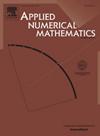An inverse problem of determining the parameters in diffusion equations by using fractional physics-informed neural networks
IF 2.2
2区 数学
Q1 MATHEMATICS, APPLIED
引用次数: 0
Abstract
In this study, we address an inverse problem in nonlinear time-fractional diffusion equations using a deep neural network. The challenge arises from the equation's nonlinear behavior, the involvement of time-based fractional Caputo derivatives, and the need to estimate parameters influenced by space or the solution of the fractional PDE. Our solution involves a fractional physics-informed neural network (FPINN). Initially, we use FPINN to solve a straightforward problem. Then, we apply FPINN to the inverse problem of estimating parameter and model non-linearity. For the inverse problem, we enhance our method by including the mean square error of final observations in the FPINN's cost function. This adjustment helps effectively in tackling the unique challenges of the time-fractional diffusion equation. Numerical tests involving regular and singular examples demonstrate the effectiveness of the physics-informed neural network approach in accurately recovering parameters. We reinforce this finding through a numerical comparison with alternative methods such as the alternating direction multiplier method (ADMM), the gradient descent, and the DeepONets (deep operator networks) method.
利用分数阶物理信息神经网络确定扩散方程参数的反问题
在本研究中,我们使用深度神经网络解决非线性时间分数扩散方程的逆问题。挑战来自于方程的非线性行为,涉及基于时间的分数Caputo导数,以及需要估计受空间或分数PDE解影响的参数。我们的解决方案涉及一个分数物理信息神经网络(FPINN)。最初,我们使用fpin来解决一个简单的问题。然后,我们将FPINN应用于参数估计和模型非线性的反问题。对于反问题,我们通过在FPINN的代价函数中包含最终观测值的均方误差来改进我们的方法。这种调整有助于有效地解决时间分数扩散方程的独特挑战。涉及正则和奇异算例的数值试验证明了物理信息神经网络方法在精确恢复参数方面的有效性。我们通过与替代方法(如交替方向乘数法(ADMM)、梯度下降法和DeepONets(深度算子网络)方法)的数值比较来强化这一发现。
本文章由计算机程序翻译,如有差异,请以英文原文为准。
求助全文
约1分钟内获得全文
求助全文
来源期刊

Applied Numerical Mathematics
数学-应用数学
CiteScore
5.60
自引率
7.10%
发文量
225
审稿时长
7.2 months
期刊介绍:
The purpose of the journal is to provide a forum for the publication of high quality research and tutorial papers in computational mathematics. In addition to the traditional issues and problems in numerical analysis, the journal also publishes papers describing relevant applications in such fields as physics, fluid dynamics, engineering and other branches of applied science with a computational mathematics component. The journal strives to be flexible in the type of papers it publishes and their format. Equally desirable are:
(i) Full papers, which should be complete and relatively self-contained original contributions with an introduction that can be understood by the broad computational mathematics community. Both rigorous and heuristic styles are acceptable. Of particular interest are papers about new areas of research, in which other than strictly mathematical arguments may be important in establishing a basis for further developments.
(ii) Tutorial review papers, covering some of the important issues in Numerical Mathematics, Scientific Computing and their Applications. The journal will occasionally publish contributions which are larger than the usual format for regular papers.
(iii) Short notes, which present specific new results and techniques in a brief communication.
 求助内容:
求助内容: 应助结果提醒方式:
应助结果提醒方式:


